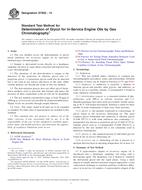Potřebujeme váš souhlas k využití jednotlivých dat, aby se vám mimo jiné mohly ukazovat informace týkající se vašich zájmů. Souhlas udělíte kliknutím na tlačítko „OK“.
ASTM D7922-14
Standard Test Method for Determination of Glycol for In-Service Engine Oils by Gas Chromatography
Automaticky přeložený název:
Standardní zkušební metoda pro stanovení glykolu pro v provozu motorových olejů plynovou chromatografií
NORMA vydána dne 15.7.2014
Informace o normě:
Označení normy: ASTM D7922-14
Poznámka: NEPLATNÁ
Datum vydání normy: 15.7.2014
Kód zboží: NS-39286
Počet stran: 7
Přibližná hmotnost: 21 g (0.05 liber)
Země: Americká technická norma
Kategorie: Technické normy ASTM
Kategorie - podobné normy:
Anotace textu normy ASTM D7922-14 :
Keywords:
antifreeze, ethylene glycol, gas chromatography, glycol, headspace, in-service oil, lubricating oil,, ICS Number Code 75.100 (Lubricants, industrial oils and related products)
Doplňující informace
| Significance and Use | ||||||||
|
5.1 Some glycol/antifreeze dilution of in-service engine oil is normal under typical operating conditions. However, excessive glycol dilution can lead to decreased performance, premature wear, or sudden engine failure. This test method provides a means of quantifying the level of glycol based antifreeze dilution, allowing the user to take necessary action. |
||||||||
| 1. Scope | ||||||||
|
1.1 This test method covers the determination of glycol based antifreeze for in-service engine oil by derivative headspace/gas chromatography. 1.2 Sample is derivatized in-situ directly in a headspace sampling vial prior to vapor phase extraction and injection into a gas chromatograph. 1.3 The chemistry of the derivatization is unique to the detection of the molecules of ethylene glycol and 1,2-propylene glycol. 1,3-propylene glycol could also be detected but is not used in any known anti-freeze at this time. Other coolant analyses are beyond the scope of this test method. 1.4 The derivatization process does not affect glycol breakdown products such as glycolate and formate and hence the presence of these compounds in the oil will not be quantified. 1.5 The test method concentration range is from 50 µg/g to 1000 µg/g. Lower levels are possible by method modifications. Higher levels are possible through sample dilution. 1.6 Units—The values stated in SI units are to be regarded as standard. No other units of measurement are included in this standard. 1.7 This standard does not purport to address all of the safety concerns, if any, associated with its use. It is the responsibility of the user of this standard to establish appropriate safety and health practices and determine the applicability of regulatory limitations prior to use. |
||||||||
| 2. Referenced Documents | ||||||||
|




 Cookies
Cookies
